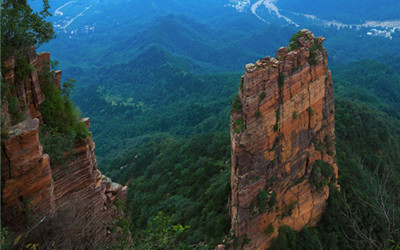Skype: neodalle-travel
Tel: +86 135 7447 2266
E-mail: sales@zhangjiajieholiday.com
 North of Henan
North of HenanSouth of Henan
South of the Huang He there is a broad stretch of upland comprising a number of moderately high mountain basins, the main ranges being the Xiong’er and Funiu. These mountains, which have an east-west trend, are the eastern extension of the Qin (Tsinling) Mountain axis that divides China geologically and geographically into North and South. The Tongbai and Dabie ranges form a further extension of this axis, running in a southeasterly direction and marking the border between Henan and Hubei. The Tongbai range is separated from the Funiu by a gap some 75 to 100 miles (120 to 160 km) wide cut by the Tang and Bai rivers, which are tributaries of the Han River. This gap gives easy access from the Henan Plain to the central basin of the Yangtze River (Chang Jiang), a route much used from Han times onward in Chinese expansion southward.
East of Henan
To the east lie the plains. Until fairly recent geological times the mountains in the west formed the coast of a sea that, essentially, was the western extension of the present Bo Hai (Gulf of Chihli) and Yellow Sea. That sea, now filled with silt brought down by the rivers and by the wind from the Loess Plateau, forms the North China Plain and the Huai River basin; it is estimated that the sediment of the plain is now some 2,800 feet (850 metres) deep in places. It is part of the great subduction zone (downwarping part of the Earth’s crust) that extends from Anhui to Jiangxi provinces. The floor of this zone is sinking at a rate equal to that of deposition.
Rivers in Henan
Henan has three river systems: the Yellow River in the north and northeast, the Huai River in the east and southeast, and the Tang and Bai rivers in the southwest. The latter two drain southward into Hubei, eventually joining the Han River (a major tributary of the Yangtze River.
Yellow River, also Huanghe River, known in Chinese literature simply as the He (“River”)—turns eastward (immediately after its confluence with the Wei River) just west of the junction of the borders of Shaanxi, Shanxi, and Henan. From there it soon enters the Sanmen Gorge, flowing east-northeast for some 80 miles (130 km) between Shanxi and Henan before issuing onto the plain and flowing east directly across northern Henan. It is remarkable that from the confluence with the Wei to the sea, a distance of about 600 miles (1,000 km), the Huang He receives only two comparatively small tributaries: the right-bank Luo River, on which Luoyang stands, and the left-bank Qin River.
Huai River itself and all its major left-bank tributaries have their sources in the mountains of southwestern Henan. They flow eastward onto the Anhui Plain, subjecting it to disastrous floods. In 1949 the Huai basin became the communist regime’s first large water-conservancy program. Six dams were quickly built in the upper reaches of Huai tributaries in Henan. Since 1957 more than 20 large dams, including those at Xianghongdian, Meishan, and Foziling, have been built. Dikes were strengthened, with the result that no serious disaster has since occurred.
Soils of Henan
Henan’s soils are made up mainly of calcium carbonate (lime) in hardened layers of alluvium. Because of comparatively low precipitation levels, there is little leaching. The higher land of the west is mainly mountain yellow-brown earth, better drained than the plains. The more fertile areas fringing the plains were the sites of early civilization. Alluvium is spread throughout the plains; it is yellowish and gray, porous, granular, and poor in organic matter. Since the bed of the Huang He lies above the surrounding land, much of the low-lying land on either side is waterlogged. Consequently, soil salinity and alkalinity affect the whole area. There are large areas of bleak, white saline sands. Since 1949 there has been much experimentation aimed at bringing these alkaline lands into production. Between 1954 and 1964 one-fourth of the saline land between Kaifeng and Zhengzhou reportedly was transformed into fertile farmland; since then, efforts to reclaim saline and alkaline land have continued, though with limited or short-lived success.
Plants & Animals in Henan
The natural vegetation of Henan is deciduous forest and woodland over the plains, and deciduous and coniferous forest in the western highlands. Intensive settlement of the plains has long since led to the clearance of the trees to make way for cultivation. The mountains, however, retain some of their woodland. Since 1949 major efforts have been made in planting trees for shelter, timber, and other uses. More than 400 varieties of vertebrate land animals inhabit the province, most of them living in the upland forests. A number of species are endangered, including the serow (Capricornis sumatraensis), a type of mountain goat.
 Ask Questions ?
Ask Questions ?